In February, the tone so loses its leaves and one awaits with impatience to see its delicious, perfumed flowers appear.
Gmelina arborea is a large tree with a straight trunk surmounted by a crown of narrow, but quite dense foliage. Its bark is pale grey, its yellow, angular branches are covered with little red holes. Its large leaves are simple, opposite each other, in the form of a heart; gently tough, they are pubescent on the underside; they fall in the dry season, when it is well underway. The flowers appear after the leaves have fallen; they are velvety, deliciously perfumed, and divided around the end of the bare branches; each is yellow and brown with crimson spots; the flower resembles a wolf’s mouth, emerging from a brown, hairy calyx. The funnel-shaped corolla is formed of five lobed, unequal joints: the highest two curve towards the back, the lower three, curve towards the front, the one in the middle being larger than the other four. In their centre are four stamens: two large, and two small. The fruit is a roundish drupe, with a shiny skin which turns from green to yellow, and is filled with an aromatic, edible pulp.
This tree originated in India and is equally known in the regions ranging from Burma to Vietnam, passing through southern China; it grows in the forests where it mingles with both evergreens and deciduous trees.
It was given its name by Linne, in honour of a German botanist, Johann Gottlieb Gmelin. The english names evokes the form of flowers, like the “snapdragons” and in French, for lack of anything better, we have chosen the commercial name of the wood, gambar. The Lao name, tone so, seems accepted throughout the territory, according to the spelling it could mean “slender” or “leaning”.
In 1950, Petelot wrote that,”the tree does not seem to be used in Indo-China”, nevertheless, the Lao are first to say that its flowers are good to eat; more precisely, that they serve to sweeteen and/or color a cake made of sticky rice and steamed, which is called khaonom so. The pretty yellow flowers that grow high in the tree are not able to be picked, one has to wait until they fall to the ground, then check that they are not too bruised ; however, one can dry and keep them for a certain amount of time. This culinary speciality belongs to the ethnic Lue. Elsewhere in the country, tone so is considered to have medicinal properties; a decoction of roots treats fevers and also typhoid; the leaves fight against the numerous fungi which bother the people who spend a lot of time working in water. Furthermore, tone so has been selected as a species to be protected, to propagate, for the qualities of its wood and its rapid growth.
En février le tone so perd ses feuilles et on attend avec impatience de voir apparaître ses délicieuses fleurs parfumées.
Gmelina arborea est un grand arbre au tronc droit surmonté d’une couronne de feuillage étroite mais assez dense. Son écorce est gris pâle, ses jeunes rameaux anguleux sont couverts de petits poils roux. Ses grandes feuilles sont simples, opposées, en forme de cœur; légèrement coriaces elles sont pubescentes sur leur face inférieure; elles tombent en saison sèche quand celle-ci est bien marquée. Les fleurs apparaissent après que les feuilles soient tombées ; elles sont veloutées, délicieusement parfumées, et se répartissent au bout des rameaux nus; chacune d’elle est jaune et brune avec des taches pourpres; elle ressemble à une gueule de loup émergeant d’un calice brun et poilu; la corolle en forme d’entonnoir est formée de 5 lobes inégaux joints; les 2 du haut sont recourbés vers l’arrière, les 3 du bas, se recourbent vers l’avant, celui du milieu étant plus grand que les autres; en leur centre sont les 4 étamines, 2 grandes et 2 petites. Le fruit est une drupe à peu près ronde avec une peau luisante, verte puis jaune, remplie d’une pulpe aromatique comestible.
Cet arbre originaire d’Inde est également courant dans des régions allant de la Birmanie au Vietnam en passant par le sud de la Chine; il habite les forêts où se mêlent arbres toujours verts et arbres caduques.
Son nom lui a été donné par Linné en l’honneur d’un botaniste allemand Johann Gottlieb Gmelin. Le nom anglais évoque la forme des fleurs, comme des « gueules de loup » et en français, faute de mieux, nous avons choisi le nom commercial du bois gambar. Le nom lao tone so semble admis sur l’ensemble du territoire, selon l’orthographe il signifierait « mince » ou « penché ».
Petelot en 1950 écrit que « l’arbre ne semble pas employé en Indochine », pourtant les Lao disent, en premier lieu, que ses fleurs sont bonnes à manger; plus précisément elles servent à parfumer et/ou à colorer un gâteau fait de riz gluant et cuit à la vapeur que l’on nomme khaonom so. Les jolies fleurs jaunes qui sont haut sur l’arbre ne peuvent être cueillies, il faut attendre qu’elles tombent à terre et surveiller qu’elles ne soient pas trop abîmées; cependant on peut les faire sécher et les conserver un certain temps. Cette spécialité culinaire appartient à l’ethnie Leu. Ailleurs dans le pays tone so est considéré comme ayant des propriétés médicinales; une décoction des racines traite les fièvres et même la typhoïde; les feuilles permettraient de lutter contre les nombreux champignons qui atteignent les gens travaillant longtemps dans l’eau. En outre, tone so a été sélectionné comme espèce à protéger, à propager, pour les qualités de son bois et sa croissance très rapide.
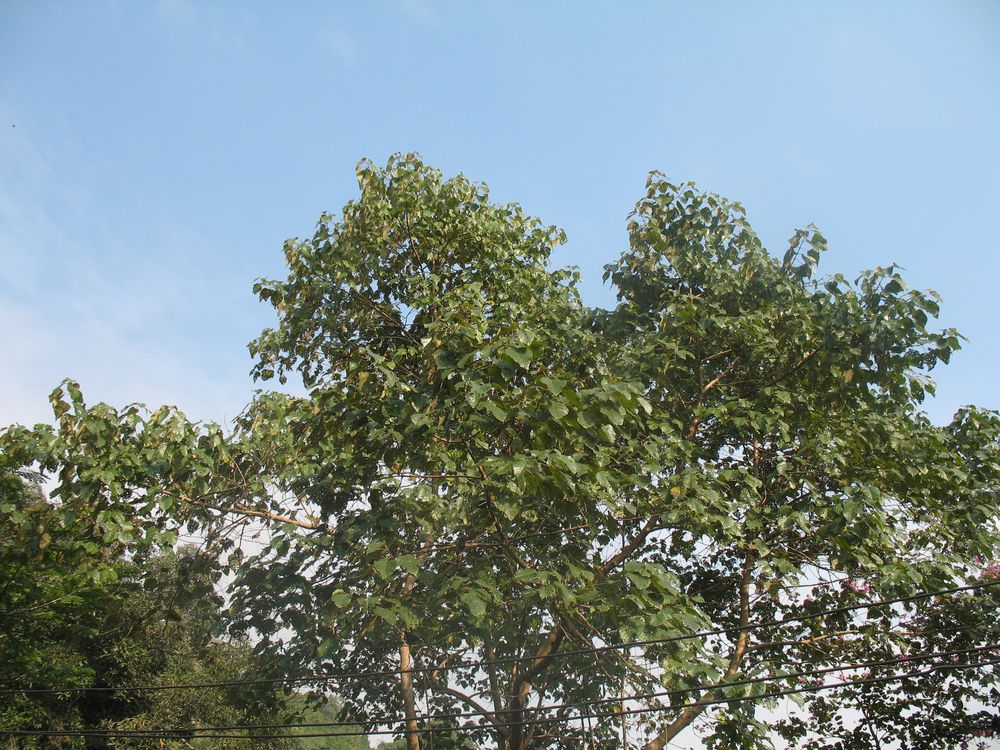
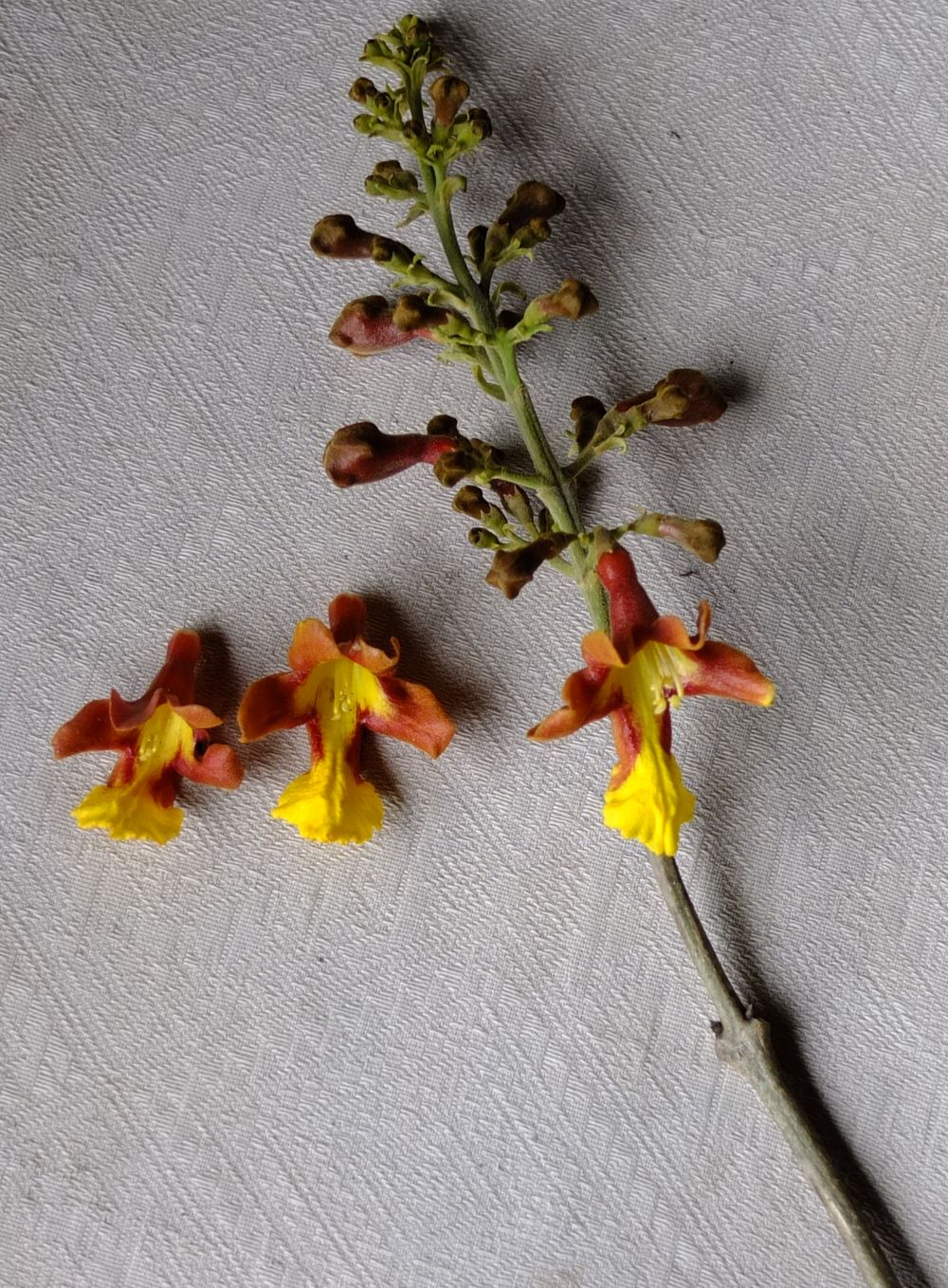
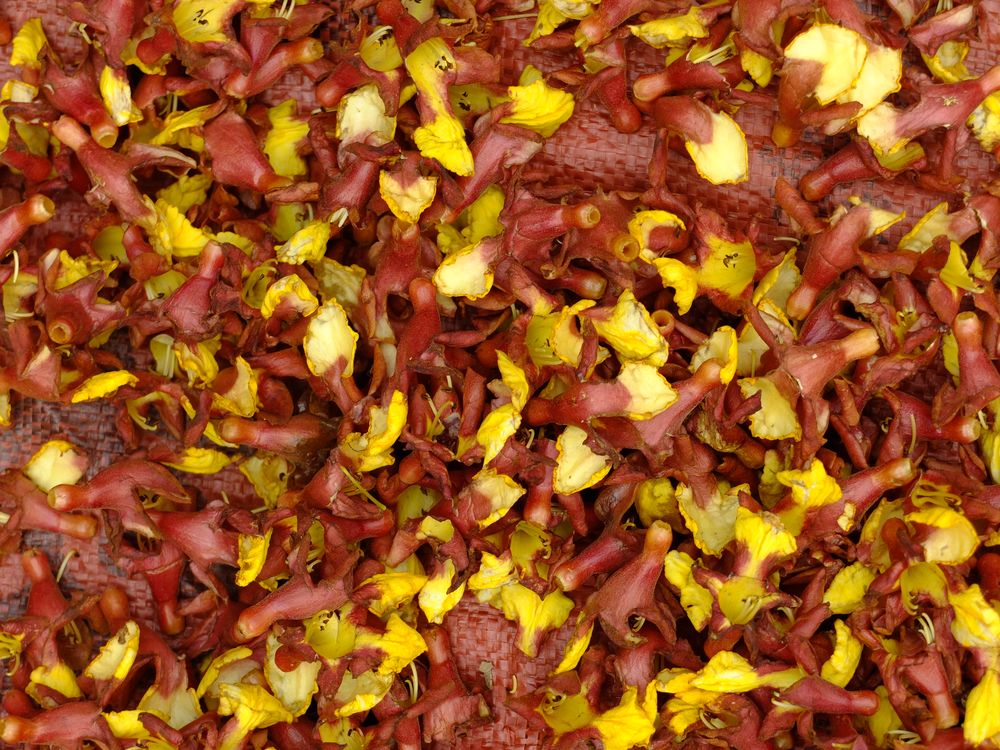
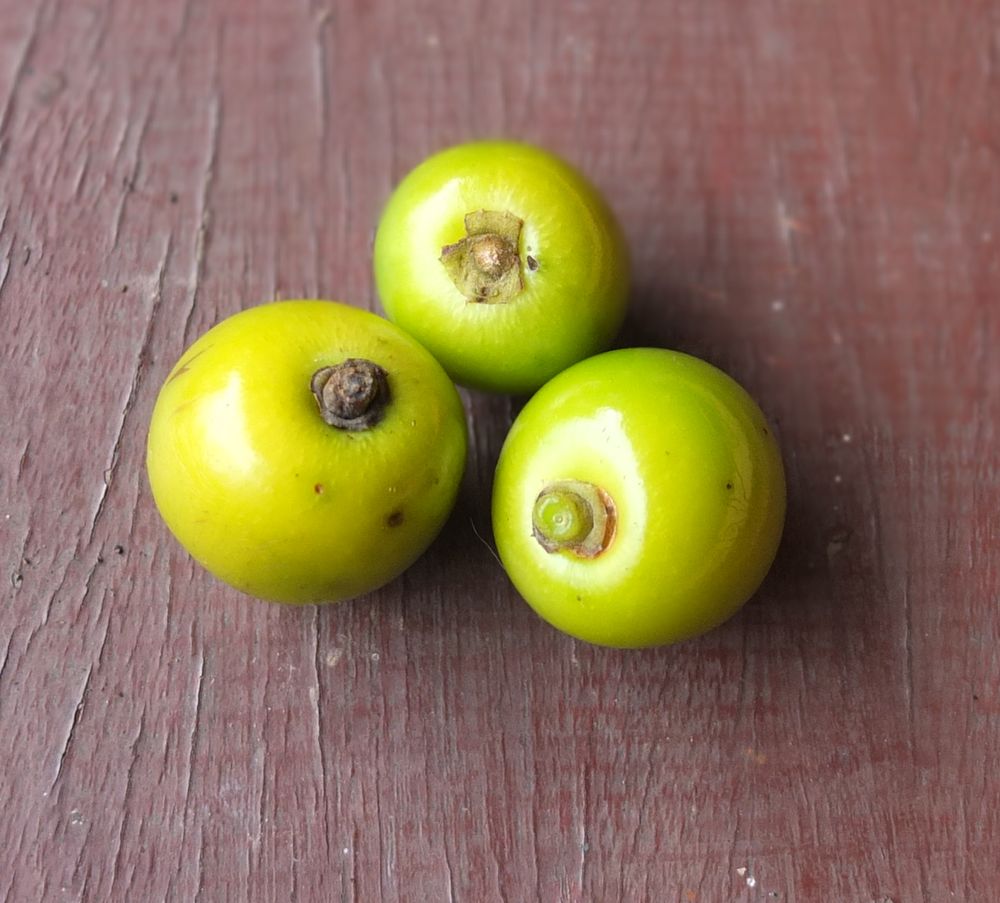
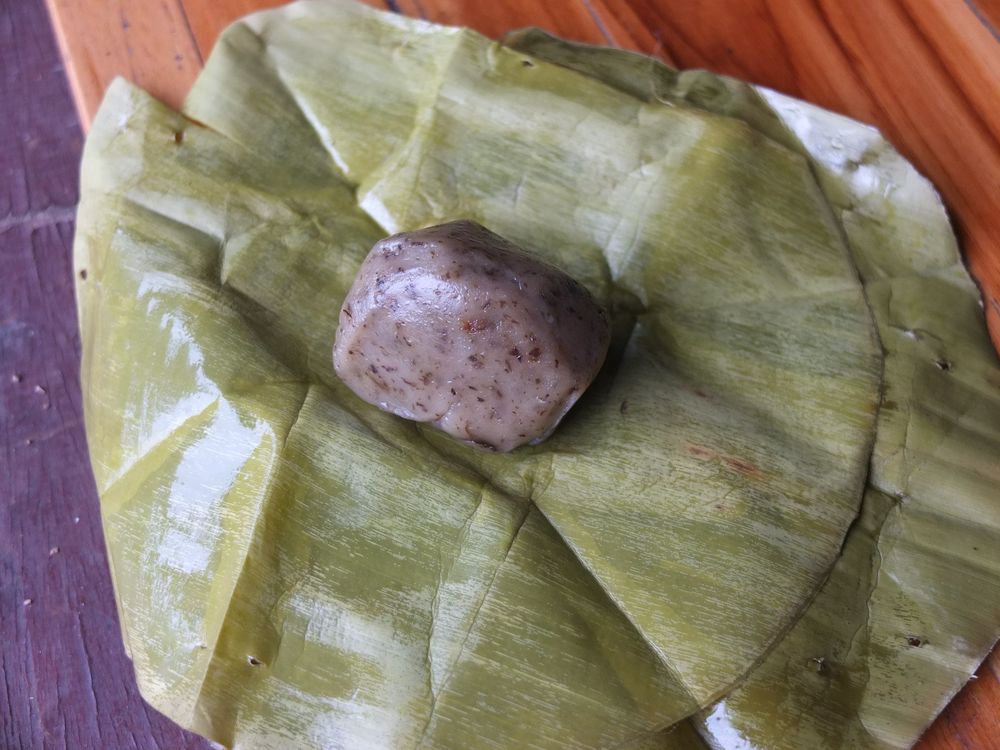
In February, the tone so loses its leaves and one awaits with impatience to see its delicious, perfumed flowers appear.
Gmelina arborea is a large tree with a straight trunk surmounted by a crown of narrow, but quite dense foliage. Its bark is pale grey, its yellow, angular branches are covered with little red holes. Its large leaves are simple, opposite each other, in the form of a heart; gently tough, they are pubescent on the underside; they fall in the dry season, when it is well underway. The flowers appear after the leaves have fallen; they are velvety, deliciously perfumed, and divided around the end of the bare branches; each is yellow and brown with crimson spots; the flower resembles a wolf’s mouth, emerging from a brown, hairy calyx. The funnel-shaped corolla is formed of five lobed, unequal joints: the highest two curve towards the back, the lower three, curve towards the front, the one in the middle being larger than the other four. In their centre are four stamens: two large, and two small. The fruit is a roundish drupe, with a shiny skin which turns from green to yellow, and is filled with an aromatic, edible pulp.
This tree originated in India and is equally known in the regions ranging from Burma to Vietnam, passing through southern China; it grows in the forests where it mingles with both evergreens and deciduous trees.
It was given its name by Linne, in honour of a German botanist, Johann Gottlieb Gmelin. The english names evokes the form of flowers, like the “snapdragons” and in French, for lack of anything better, we have chosen the commercial name of the wood, gambar. The Lao name, tone so, seems accepted throughout the territory, according to the spelling it could mean “slender” or “leaning”.
In 1950, Petelot wrote that,”the tree does not seem to be used in Indo-China”, nevertheless, the Lao are first to say that its flowers are good to eat; more precisely, that they serve to sweeteen and/or color a cake made of sticky rice and steamed, which is called khaonom so. The pretty yellow flowers that grow high in the tree are not able to be picked, one has to wait until they fall to the ground, then check that they are not too bruised ; however, one can dry and keep them for a certain amount of time. This culinary speciality belongs to the ethnic Lue. Elsewhere in the country, tone so is considered to have medicinal properties; a decoction of roots treats fevers and also typhoid; the leaves fight against the numerous fungi which bother the people who spend a lot of time working in water. Furthermore, tone so has been selected as a species to be protected, to propagate, for the qualities of its wood and its rapid growth.
En février le tone so perd ses feuilles et on attend avec impatience de voir apparaître ses délicieuses fleurs parfumées.
Gmelina arborea est un grand arbre au tronc droit surmonté d’une couronne de feuillage étroite mais assez dense. Son écorce est gris pâle, ses jeunes rameaux anguleux sont couverts de petits poils roux. Ses grandes feuilles sont simples, opposées, en forme de cœur; légèrement coriaces elles sont pubescentes sur leur face inférieure; elles tombent en saison sèche quand celle-ci est bien marquée. Les fleurs apparaissent après que les feuilles soient tombées ; elles sont veloutées, délicieusement parfumées, et se répartissent au bout des rameaux nus; chacune d’elle est jaune et brune avec des taches pourpres; elle ressemble à une gueule de loup émergeant d’un calice brun et poilu; la corolle en forme d’entonnoir est formée de 5 lobes inégaux joints; les 2 du haut sont recourbés vers l’arrière, les 3 du bas, se recourbent vers l’avant, celui du milieu étant plus grand que les autres; en leur centre sont les 4 étamines, 2 grandes et 2 petites. Le fruit est une drupe à peu près ronde avec une peau luisante, verte puis jaune, remplie d’une pulpe aromatique comestible.
Cet arbre originaire d’Inde est également courant dans des régions allant de la Birmanie au Vietnam en passant par le sud de la Chine; il habite les forêts où se mêlent arbres toujours verts et arbres caduques.
Son nom lui a été donné par Linné en l’honneur d’un botaniste allemand Johann Gottlieb Gmelin. Le nom anglais évoque la forme des fleurs, comme des « gueules de loup » et en français, faute de mieux, nous avons choisi le nom commercial du bois gambar. Le nom lao tone so semble admis sur l’ensemble du territoire, selon l’orthographe il signifierait « mince » ou « penché ».
Petelot en 1950 écrit que « l’arbre ne semble pas employé en Indochine », pourtant les Lao disent, en premier lieu, que ses fleurs sont bonnes à manger; plus précisément elles servent à parfumer et/ou à colorer un gâteau fait de riz gluant et cuit à la vapeur que l’on nomme khaonom so. Les jolies fleurs jaunes qui sont haut sur l’arbre ne peuvent être cueillies, il faut attendre qu’elles tombent à terre et surveiller qu’elles ne soient pas trop abîmées; cependant on peut les faire sécher et les conserver un certain temps. Cette spécialité culinaire appartient à l’ethnie Leu. Ailleurs dans le pays tone so est considéré comme ayant des propriétés médicinales; une décoction des racines traite les fièvres et même la typhoïde; les feuilles permettraient de lutter contre les nombreux champignons qui atteignent les gens travaillant longtemps dans l’eau. En outre, tone so a été sélectionné comme espèce à protéger, à propager, pour les qualités de son bois et sa croissance très rapide.










In February, the tone so loses its leaves and one awaits with impatience to see its delicious, perfumed flowers appear.
Gmelina arborea is a large tree with a straight trunk surmounted by a crown of narrow, but quite dense foliage. Its bark is pale grey, its yellow, angular branches are covered with little red holes. Its large leaves are simple, opposite each other, in the form of a heart; gently tough, they are pubescent on the underside; they fall in the dry season, when it is well underway. The flowers appear after the leaves have fallen; they are velvety, deliciously perfumed, and divided around the end of the bare branches; each is yellow and brown with crimson spots; the flower resembles a wolf’s mouth, emerging from a brown, hairy calyx. The funnel-shaped corolla is formed of five lobed, unequal joints: the highest two curve towards the back, the lower three, curve towards the front, the one in the middle being larger than the other four. In their centre are four stamens: two large, and two small. The fruit is a roundish drupe, with a shiny skin which turns from green to yellow, and is filled with an aromatic, edible pulp.
This tree originated in India and is equally known in the regions ranging from Burma to Vietnam, passing through southern China; it grows in the forests where it mingles with both evergreens and deciduous trees.
It was given its name by Linne, in honour of a German botanist, Johann Gottlieb Gmelin. The english names evokes the form of flowers, like the “snapdragons” and in French, for lack of anything better, we have chosen the commercial name of the wood, gambar. The Lao name, tone so, seems accepted throughout the territory, according to the spelling it could mean “slender” or “leaning”.
In 1950, Petelot wrote that,”the tree does not seem to be used in Indo-China”, nevertheless, the Lao are first to say that its flowers are good to eat; more precisely, that they serve to sweeteen and/or color a cake made of sticky rice and steamed, which is called khaonom so. The pretty yellow flowers that grow high in the tree are not able to be picked, one has to wait until they fall to the ground, then check that they are not too bruised ; however, one can dry and keep them for a certain amount of time. This culinary speciality belongs to the ethnic Lue. Elsewhere in the country, tone so is considered to have medicinal properties; a decoction of roots treats fevers and also typhoid; the leaves fight against the numerous fungi which bother the people who spend a lot of time working in water. Furthermore, tone so has been selected as a species to be protected, to propagate, for the qualities of its wood and its rapid growth.
En février le tone so perd ses feuilles et on attend avec impatience de voir apparaître ses délicieuses fleurs parfumées.
Gmelina arborea est un grand arbre au tronc droit surmonté d’une couronne de feuillage étroite mais assez dense. Son écorce est gris pâle, ses jeunes rameaux anguleux sont couverts de petits poils roux. Ses grandes feuilles sont simples, opposées, en forme de cœur; légèrement coriaces elles sont pubescentes sur leur face inférieure; elles tombent en saison sèche quand celle-ci est bien marquée. Les fleurs apparaissent après que les feuilles soient tombées ; elles sont veloutées, délicieusement parfumées, et se répartissent au bout des rameaux nus; chacune d’elle est jaune et brune avec des taches pourpres; elle ressemble à une gueule de loup émergeant d’un calice brun et poilu; la corolle en forme d’entonnoir est formée de 5 lobes inégaux joints; les 2 du haut sont recourbés vers l’arrière, les 3 du bas, se recourbent vers l’avant, celui du milieu étant plus grand que les autres; en leur centre sont les 4 étamines, 2 grandes et 2 petites. Le fruit est une drupe à peu près ronde avec une peau luisante, verte puis jaune, remplie d’une pulpe aromatique comestible.
Cet arbre originaire d’Inde est également courant dans des régions allant de la Birmanie au Vietnam en passant par le sud de la Chine; il habite les forêts où se mêlent arbres toujours verts et arbres caduques.
Son nom lui a été donné par Linné en l’honneur d’un botaniste allemand Johann Gottlieb Gmelin. Le nom anglais évoque la forme des fleurs, comme des « gueules de loup » et en français, faute de mieux, nous avons choisi le nom commercial du bois gambar. Le nom lao tone so semble admis sur l’ensemble du territoire, selon l’orthographe il signifierait « mince » ou « penché ».
Petelot en 1950 écrit que « l’arbre ne semble pas employé en Indochine », pourtant les Lao disent, en premier lieu, que ses fleurs sont bonnes à manger; plus précisément elles servent à parfumer et/ou à colorer un gâteau fait de riz gluant et cuit à la vapeur que l’on nomme khaonom so. Les jolies fleurs jaunes qui sont haut sur l’arbre ne peuvent être cueillies, il faut attendre qu’elles tombent à terre et surveiller qu’elles ne soient pas trop abîmées; cependant on peut les faire sécher et les conserver un certain temps. Cette spécialité culinaire appartient à l’ethnie Leu. Ailleurs dans le pays tone so est considéré comme ayant des propriétés médicinales; une décoction des racines traite les fièvres et même la typhoïde; les feuilles permettraient de lutter contre les nombreux champignons qui atteignent les gens travaillant longtemps dans l’eau. En outre, tone so a été sélectionné comme espèce à protéger, à propager, pour les qualités de son bois et sa croissance très rapide.


